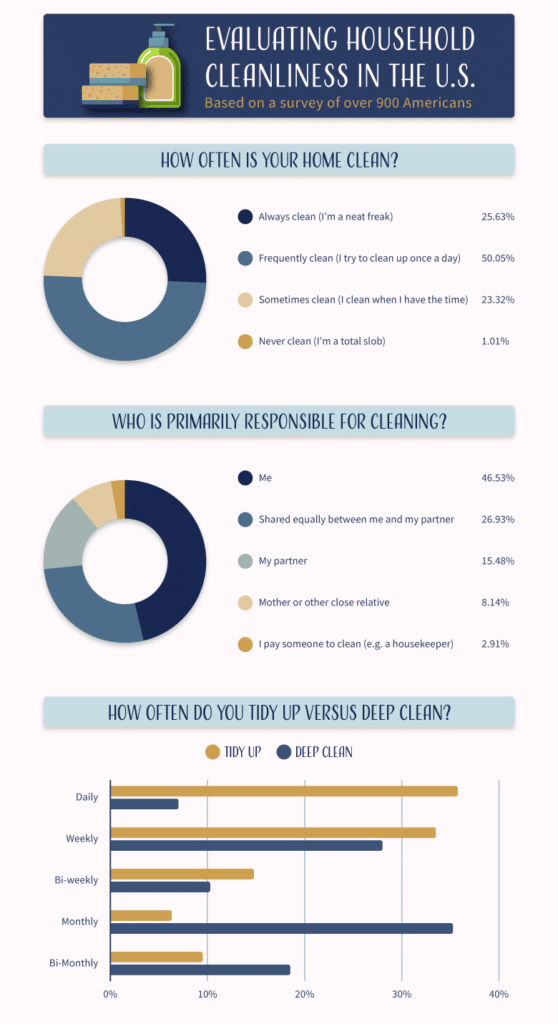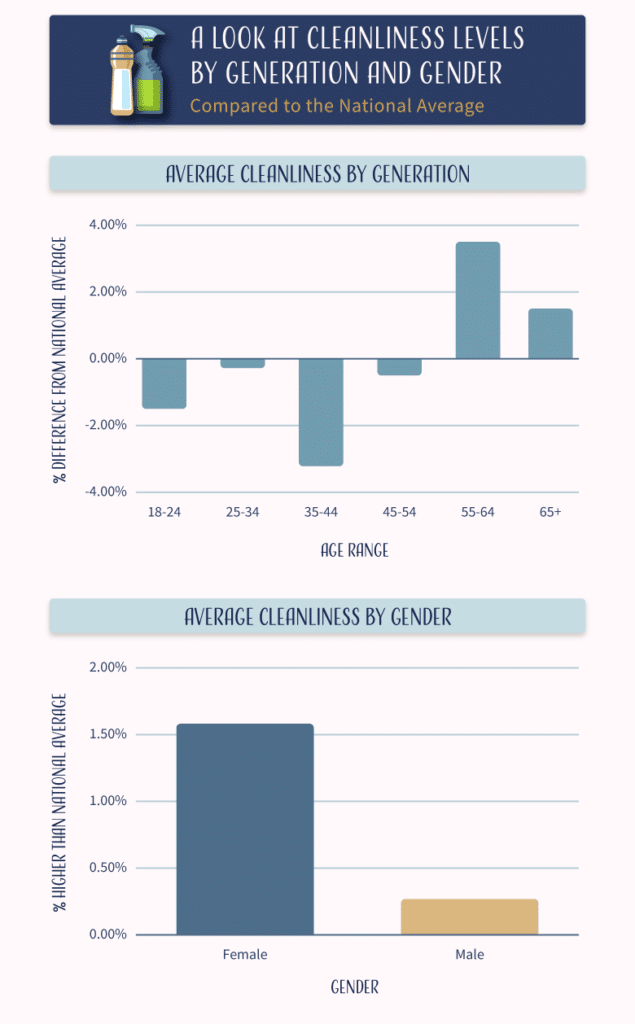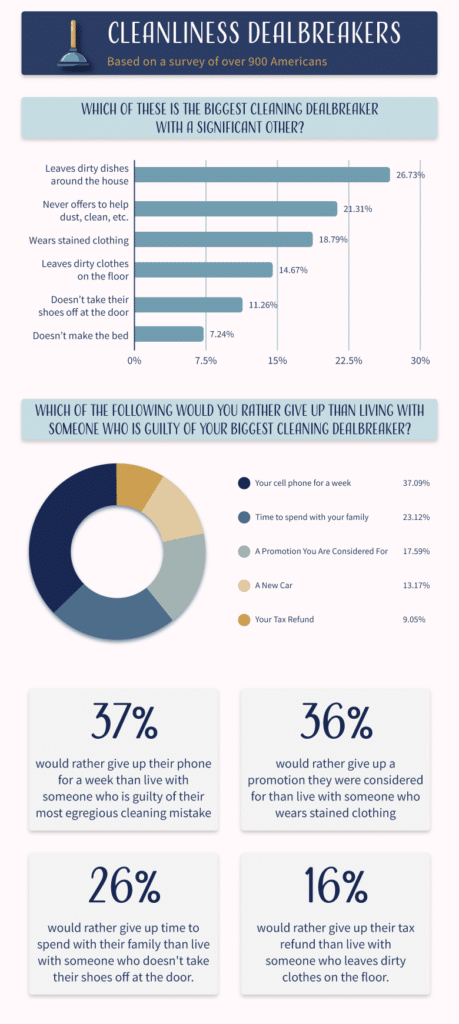Imagine a world where dust bunnies rule the land, dirty dishes hold court in the sink, and the vacuum cleaner is nothing more than a forgotten relic stuck in the closet. Well, folks, welcome to the average American home. In this eye-opening article, we’ll take you on a journey through the murky depths of cleanliness, exploring just how tidy (or not) our beloved abodes really are. Get ready to hold your breath and bring out the Hazmat suits, because this is about to get messy.
Statistics on Cleanliness
Percentage of Americans who clean their homes regularly
When it comes to cleanliness, it appears that the average American may not be as diligent as we would hope. In fact, studies have shown that only a mere 47% of Americans clean their homes regularly. That means more than half of the population is potentially living in less-than-sparkling abodes. But fear not, for the remaining 53% may simply have a different definition of “regular” cleaning than the rest of us.
Frequency of cleaning activities
For those who do clean their homes regularly, it seems that the frequency of their cleaning activities varies widely. Some dedicated souls may tackle their cleaning tasks on a daily basis, ensuring a perpetually tidy living space. Others, however, may take a more relaxed approach and engage in a weekly or even monthly cleaning routine. And then there are those who simply embrace the chaos and rarely pick up a mop or vacuum cleaner. Whatever their level of dedication, it’s safe to say that everyone has their own unique standards of cleanliness.
Common cleaning habits
When it comes to cleaning, it seems that Americans have their tried-and-true methods. Dusting, vacuuming, and wiping down surfaces are commonly reported as the most frequently performed cleaning activities. However, it’s worth noting that these cleaning habits can vary depending on the individual’s preferences and priorities. Some may prioritize tidying up cluttered areas, while others may focus on keeping their floors spotless. Nevertheless, it’s clear that Americans have a knack for finding their own groove when it comes to keeping their homes clean.
Time spent on cleaning
If you’ve ever felt like you spend more time cleaning than enjoying your living space, you’re not alone. On average, Americans spend approximately 2.5 hours per week cleaning their homes. While this may not seem like a significant amount of time, it adds up to over 130 hours a year spent scrubbing, sweeping, and polishing. That’s enough time to binge-watch several seasons of your favorite TV show! With that in mind, maybe it’s time to reevaluate our cleaning priorities and find ways to streamline our cleaning routines.
Cleaning Products Usage
Types of cleaning products used
When it comes to tackling household chores, Americans have an arsenal of cleaning products at their disposal. From multi-purpose sprays to specialized cleaners for specific surfaces, the options are seemingly endless. Some popular cleaning product categories include all-purpose cleaners, glass cleaners, disinfectants, and floor cleaners. It’s safe to say that Americans like having an array of choices when it comes to keeping their homes spick and span.
Chemicals in cleaning products
While the array of cleaning products available can make our homes shine, it’s important to be aware of the potential chemicals lurking in these products. Many cleaning products contain ingredients that can be harmful to both our health and the environment. Harsh chemicals like bleach, ammonia, and phthalates can irritate our skin, eyes, and respiratory system. It’s always wise to read labels carefully and opt for eco-friendly or natural cleaning products whenever possible.
Environmental impact of cleaning products
In the pursuit of a clean home, it’s easy to overlook the environmental impact of our cleaning choices. Many conventional cleaning products contain ingredients that may contribute to water pollution and harm aquatic life when they inevitably find their way down our drains. Additionally, the production and packaging of these products often involve the use of non-renewable resources. Thankfully, there are eco-friendly alternatives available that are safer for both our planet and our homes.

This image is property of thewaycroft.com.
Germs and Bacteria
Presence of germs and bacteria in American homes
No matter how clean we may think our homes are, the truth is that they are teeming with germs and bacteria. In fact, studies have shown that the average American home contains hundreds of different types of bacteria, including some potentially harmful strains. While this may sound alarming, it’s important to remember that not all bacteria are bad, and a certain level of microbial diversity is actually beneficial for our immune systems. So, instead of fretting over every germ, we should focus on maintaining a clean and hygienic living environment.
Areas with the most germs
While germs can be found throughout our homes, certain areas tend to harbor more bacteria than others. The kitchen, for example, is a hotbed for microbial activity due to its frequent use and exposure to various food particles. Surprisingly, the bathroom, often associated with cleanliness, is another area where germs thrive. Other frequently contaminated areas include doorknobs, light switches, and remote controls. Regular cleaning and disinfection of these germ “hotspots” can help minimize the risk of illness.
Health risks associated with germs
Germs and bacteria may be tiny, but they can have a big impact on our health. Harmful bacteria like E. coli and Salmonella can cause food poisoning, leading to symptoms such as nausea, vomiting, and diarrhea. Additionally, bacteria like Staphylococcus aureus and Streptococcus can lead to skin infections and respiratory illnesses. By maintaining a clean and hygienic home, we can reduce the risk of these illnesses and create a healthier living environment for ourselves and our loved ones.
Dust and Allergens
Amount of dust in American homes
Dust may seem like a harmless annoyance, but it’s more prevalent in our homes than we may realize. On average, American homes accumulate around 40 pounds of dust each year. That’s a significant amount of microscopic particles that can settle on our surfaces, furniture, and even in the air we breathe. So, if you’ve ever wondered why you feel like you’re constantly battling dust, rest assured that you’re not alone in this never-ending war.
Common allergens found in homes
Dust isn’t only made up of harmless dirt and skin flakes; it’s also a haven for allergens. Common allergens found in dust include pollen, pet dander, and dust mites. These microscopic irritants can trigger allergies, causing symptoms like itchy eyes, sneezing, and congestion. For individuals with asthma or other respiratory conditions, these allergens can be particularly problematic, leading to flare-ups and breathing difficulties. Regular dusting and cleaning can help reduce the presence of these allergens, providing relief for allergy sufferers.
Impact on respiratory health
The presence of dust and allergens in our homes can have a significant impact on our respiratory health. Inhaling dust particles and allergens can irritate our airways, leading to symptoms like coughing, wheezing, and shortness of breath. For individuals with pre-existing respiratory conditions like asthma, exposure to these irritants can exacerbate their symptoms and make it more difficult to breathe freely. By keeping our homes as dust-free as possible, we can promote better respiratory health for ourselves and our families.

This image is property of thewaycroft.com.
Kitchen Hygiene
Frequency of kitchen cleaning
The kitchen is often considered the heart of the home, but it can also be a breeding ground for bacteria if not properly cleaned and maintained. It’s recommended to clean your kitchen at least once a day, paying close attention to frequently used surfaces like countertops, cutting boards, and sinks. Regularly sanitizing and disinfecting these areas can help prevent cross-contamination and keep foodborne illnesses at bay.
Food-borne illnesses
Improper kitchen cleanliness and food handling practices can increase the risk of foodborne illnesses. Bacteria like Salmonella, Campylobacter, and E. coli can contaminate our food and cause illnesses ranging from mild gastrointestinal discomfort to severe infections. To reduce the risk of foodborne illnesses, it’s important to regularly clean kitchen utensils and surfaces, wash hands thoroughly before food preparation, and refrigerate perishable foods promptly.
Proper food handling practices
In addition to regular cleaning, proper food handling practices are essential for maintaining kitchen hygiene. Washing fruits and vegetables before consumption, storing raw meats separately from ready-to-eat foods, and cooking foods to the appropriate temperature are all important steps in preventing foodborne illnesses. By following these simple guidelines, we can ensure that our kitchens remain clean, safe, and conducive to delicious and healthy meals.
Bathroom Cleanliness
Cleaning frequency
The bathroom may not be the most glamorous room in the house, but it’s undoubtedly an area that requires regular cleaning. Ideally, bathrooms should be cleaned at least once a week to prevent the buildup of dirt, grime, and bacteria. Paying special attention to high-touch surfaces like faucets, toilet handles, and doorknobs can help reduce the spread of germs and maintain a hygienic environment.
Common bathroom germs
Despite its association with cleanliness, the bathroom is a haven for various types of germs and bacteria. E. coli, Salmonella, and Staphylococcus are just a few of the delightful organisms that can be found lurking in our bathrooms. These bacteria can cause illnesses ranging from stomach bugs to skin infections. Regular cleaning with disinfectants is crucial in keeping these bathroom germs at bay and ensuring a bacteria-free zone.
Importance of proper cleaning
Proper cleaning of the bathroom is not just about maintaining appearances; it’s about safeguarding our health as well. By eliminating germs and bacteria, we reduce the risk of infectious diseases and ensure that our bathrooms remain safe and hygienic. Regular cleaning not only promotes a sense of cleanliness but also contributes to the overall well-being of everyone in the household.

This image is property of thewaycroft.com.
Bedroom Cleanliness
Hygiene practices in bedrooms
While many of us prioritize keeping our bedrooms neat and tidy, are we truly giving them the attention they deserve in terms of cleanliness? Beyond making our beds and clearing away clutter, there are additional measures we can take to enhance the cleanliness of our sleep sanctuaries. Regularly washing bedding, vacuuming mattresses, and dusting surfaces can help reduce allergens, bacteria, and dust mites, creating a healthier environment for restful sleep.
Mites and bed bugs
As cozy as our beds may be, they can also play host to unwelcome guests in the form of dust mites and bed bugs. These microscopic creatures thrive in warm and humid environments, making our mattresses and bedding their favorite hiding spots. Their presence can contribute to allergic reactions and skin irritations. While it may be unnerving to think about these critters, regular cleaning and airing out of bedding can help keep them at bay.
Impact on sleep quality
A clean and well-maintained bedroom can have a positive impact on our sleep quality. Dust, allergens, and unpleasant odors can disrupt our sleep and leave us feeling groggy and unrefreshed. By investing time and effort into maintaining a clean bedroom environment, we can create a conducive space for a peaceful and uninterrupted slumber. So, don’t underestimate the power of a clean bedroom when it comes to getting the restorative sleep we all crave.
Living Areas and Furniture
Cleaning routines for living areas
Our living areas are the spaces where we gather, relax, and entertain, and they can get quite a bit of use and abuse. Regular cleaning and tidying of living areas should involve dusting and vacuuming surfaces, wiping down electronics, and clearing away clutter. By staying on top of our cleaning routines, we can ensure that our living spaces remain inviting and free from dirt and debris.
Dust accumulation on furniture
If you’ve ever marveled at the speed at which your furniture accumulates dust, you’re not alone. Dust has a way of settling on surfaces seemingly overnight, leaving a fine film that can diminish the beauty and cleanliness of our beloved furniture. Regular dusting and polishing can help combat this relentless enemy, allowing our furniture to shine and maintain its pristine condition.
Upholstery care
In addition to regular dusting, upholstery care is an essential aspect of maintaining cleanliness in our living areas. Fabric-covered furniture can quickly become a magnet for stains, pet hair, and allergens. Vacuuming upholstery regularly and promptly dealing with spills and stains can help prolong the life of our furniture and ensure that it remains fresh and clean. For more stubborn stains, professional cleaning may be necessary to restore the upholstery’s original beauty.

This image is property of thewaycroft.com.
Air Quality
Indoor air pollution
While we may not be able to see it, indoor air pollution is a real concern for American homes. The air we breathe indoors can contain a variety of pollutants, including dust, pet dander, volatile organic compounds (VOCs) from cleaning products, and even mold spores. Poor indoor air quality can contribute to respiratory issues, allergies, and other health problems. Ventilation, air filtration, and regular cleaning are essential in improving and maintaining good indoor air quality.
Ventilation and air circulation
Proper ventilation and air circulation play a significant role in maintaining good indoor air quality. Opening windows to let fresh air in, using exhaust fans in kitchens and bathrooms, and ensuring that air vents are clean and unobstructed can all help improve air circulation. By allowing stagnant air and pollutants to escape and fresh air to circulate, we can create a healthier living environment for ourselves and our families.
Air purifiers and filters
In addition to ventilation, air purifiers and filters can further enhance the quality of the air we breathe indoors. These devices work to remove pollutants and allergens from the air, helping to reduce respiratory irritations and allergies. Various types of air purifiers and filters are available, including those designed specifically for allergies or asthma. Investing in these technologies can be a worthwhile step towards cleaner and healthier indoor air.
Factors Affecting Cleanliness
Lifestyle and occupation
Our lifestyle and occupation can have a significant impact on the cleanliness of our homes. Those with hectic schedules or demanding jobs may find it challenging to devote sufficient time and energy to cleaning tasks. On the other hand, individuals with more leisurely lifestyles or occupations that allow for flexible hours may prioritize cleanliness and dedicate more time to cleaning. Ultimately, striking a balance between work, leisure, and cleaning is key to maintaining a clean and organized living space.
Number of occupants in a home
The number of occupants in a home can greatly influence its cleanliness. A larger household with more people means more foot traffic, more cooking, and potentially more mess. Keeping up with the cleaning needs of a larger household may require more effort and coordination, but it can also create a sense of shared responsibility and teamwork when it comes to maintaining a clean and comfortable living environment.
Pets and cleanliness
Our beloved furry friends can bring immense joy to our lives, but they can also bring their fair share of mess and dirt. Shedding fur, muddy pawprints, and occasional accidents are all part and parcel of having pets. Cleaning up after our pets, such as regular vacuuming and mopping, can help keep our homes clean and free from odors. Embracing the inevitable mess that comes with pet ownership can be a small price to pay for the unconditional love and companionship they provide.
In conclusion, cleanliness in American homes varies widely, with only a portion of the population being diligent in maintaining a clean living space. However, maintaining cleanliness is not just about appearance; it is essential for our health and well-being. Regular cleaning, proper food handling, and hygiene practices can help minimize the presence of germs, allergens, and pollutants in our homes, promoting a healthier living environment. By being aware of the impact of our cleaning habits, the chemicals in cleaning products, and the importance of good indoor air quality, we can ensure that our homes are truly clean and conducive to a happy and healthy life.

This image is property of thewaycroft.com.

